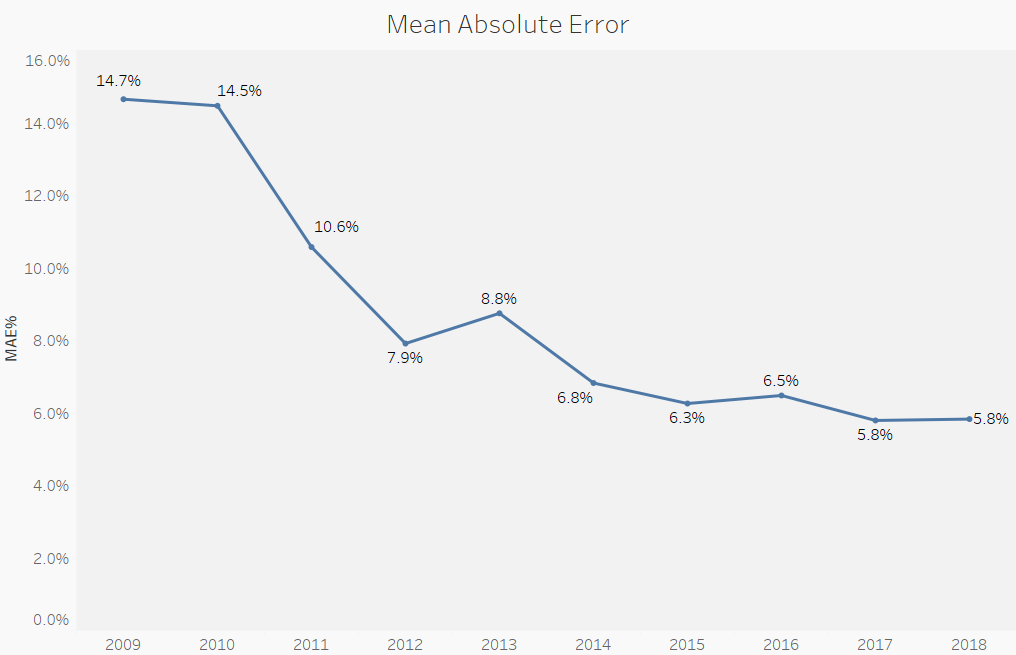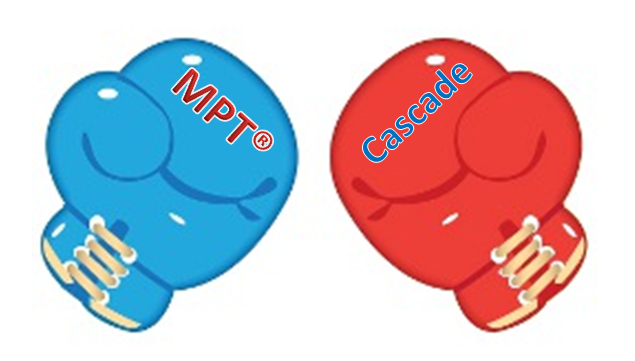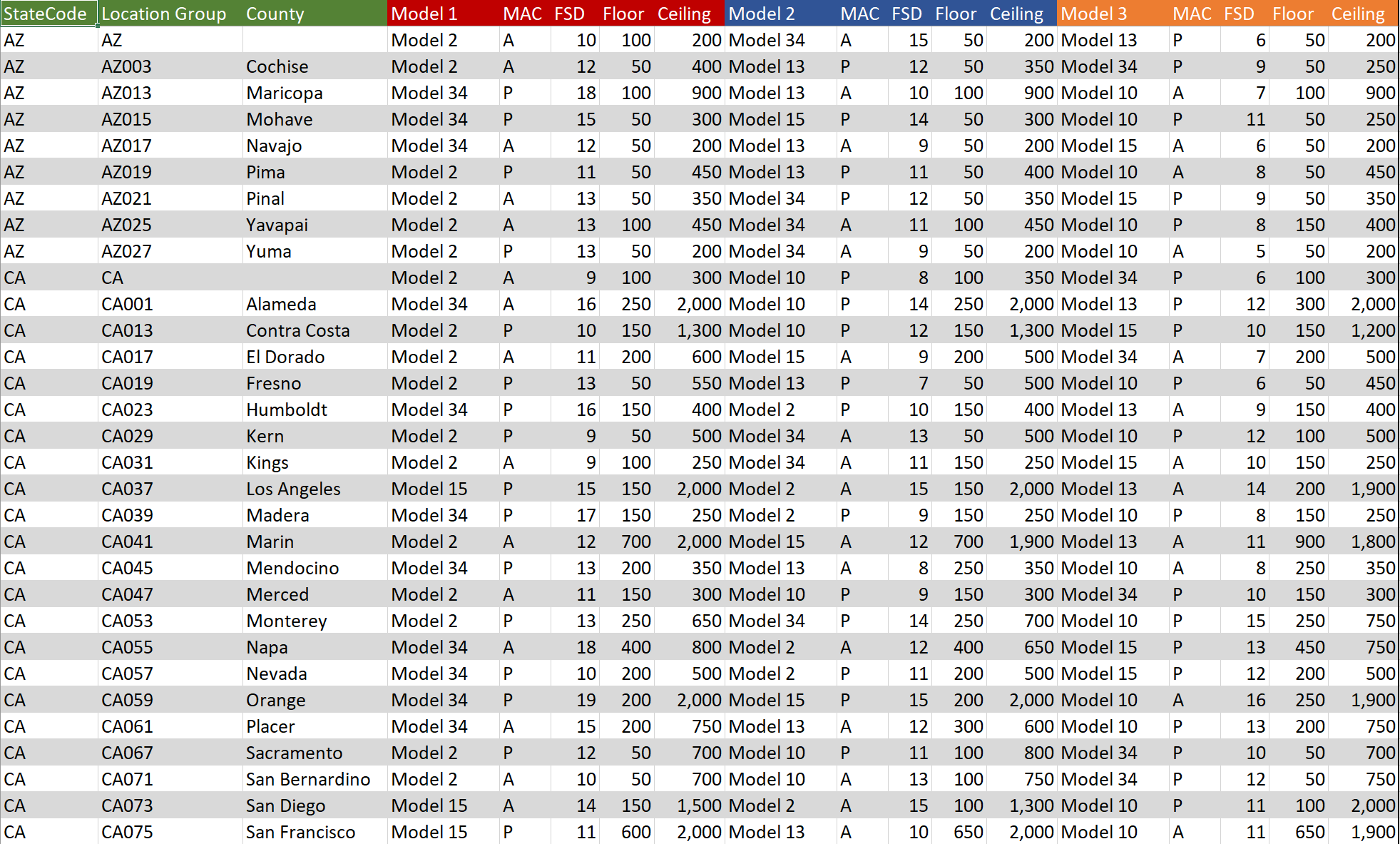AVMetics’ ongoing independent AVM testing continues in 2019 according to the attached schedule. Please use the link below to download a pdf with the entire 2019 testing schedule.
The Wild, Wild West of Automated Valuations
Recently the OCC, FDIC and the Federal Reserve proposed raising the de minimis threshold for residential properties below which appraisals are not required to complete a home loan. Currently, most homes transacting at $250K and above require an appraisal, but Federal regulators propose to raise that level to $400K. A November 30th Wall Street Journal article raises some interesting issues about the topic. They reported that the number of appraisers is down 21% since the housing crisis, but more homes require an appraiser, since more and more homes exceed the threshold each year. The article also states that these factors open the door for cheaper, faster and “largely untested” property valuations based on computer algorithms, also known as Automated Valuation Models (AVMS).
At AVMetrics, we have been continuously testing AVMs for over 15 years, so we’ve seen how they’ve performed over time. As an example, the accompanying chart shows model performance accuracy as measured by mean absolute error, a statistical metric of valuation error. We utilize many statistical measures of evaluating model accuracy and precision, and they all show significant improvement in AVMs over time. And, as these automated tools get better and the workforce of appraisers continues to shrink, the FFIEC members’ proposed change seems warranted, but that doesn’t mean they don’t have their critics.

Ratish Bansal of Appraisal Inc was quoted in The Journal describing the state of AVMs as “a wild, wild West,” inviting, “abuse of all kind.” Furthermore, he contrasts that with the voluminous regulatory standards covering the use of appraisals.
We note much of those voluminous standards represent nearly the same quality control that was in place before the Credit Crisis. In other words, appraisals are not a guarantee against collateral risk. They are simply one tool in the toolbox – an effective, but comparatively time consuming and expensive tool. Also of note, far from being the “wild, wild west,” AVMs are also governed by regulators, most notably, Appendix B of the Appraisal and Evaluation Guidelines (OOC 2010-42) and Model Risk Management guidance (OCC 2011-12). These regulatory guidelines require that AVM developers be qualified, users of AVMs use robust controls, incentives be appropriate, and models be tested regularly and thoroughly with out-of-sample benchmarks. They require documentation of risk assessments and stipulate that a Board of Directors must oversee the use of all models. In other words, if AVMs were the “the wild, wild west” they would be rooted in a town with oversight of the legendary Wyatt Earp.
My strong feeling is that appraisals should not be a sole and exclusive tool when evaluations can be effectively employed in appropriate, lower-risk scenarios. Appraisers are a valuable and limited resource, and they should be employed at (to use appraisal terminology) their highest and best use. Trying to be a “manual AVM” is not the highest and best use of a highly qualified appraiser. Their expertise should be focused on the qualitative aspects of property valuation such as the property condition and market and locational influences. They should also be focused on performing complex valuation assignments in non-homogeneous markets. AVMs do not capture and analyze the qualitative aspects of a property very well, and they still stumble in markets with highly diverse house stock or houses with less quantifiable attributes such as view properties.
However, several companies are developing ways of merging the robust data processing capabilities of an AVM with the qualitative assessment skills of appraisers. Today, these products typically use an AVM at their core and then satisfy additionally required evaluation criteria (physical property condition, market and location influences) with an additional service. For example, a lender can wrap a Property Condition Report (PCR) around the AVM and reconcile that data in support of a lending decision. This type of “Hybrid valuation” is on the track we’re headed down. Many companies have already created these types of products for commercial and proprietary use.
We at AVMetrics believe in using the right tool for the job, and we believe there is a place for automated valuations in prudent lending practices. We think the smarter approach would be to marginally raise the de minimis threshold, but simultaneously to provide additional guidance for considering other aspects of a lending decision, specifically, collateral considerations and eligibility criteria for appraisal exemptions such neighborhood homogeneity, property conformity, market conditions and more.
Subscribe to the AVMNews
AVMetrics hand-picks the best articles related to the development and use of AVMs, as well as articles about the companies and people involved in the field of AVMs around the world.
Use this link to subscribe to the AVMNews for free.
AVMetrics took over the publishing of the AVMNews in January of 2017. Newsletters are published Quarterly. You can reach the AVMNews at AVMNews@AVMetrics.net.
2018 Testing Schedule Announced
AVMetics’ ongoing independent AVM testing continues in 2018 according to the attached schedule. Please use the link below to download a pdf with the entire 2018 testing schedule.
Appraisal Foundation IAC Open Letter to Congress
IAC Opinion Letter to Congress with IAC Listing
On September 13, 2017, AVMetrics participated with its many partners in The Appraisal Foundation in sending an open letter to the House Committee on Banking, Housing and Urban Affairs urging the committee to refrain from weakening the oversight of the Appraisal Subcommittee (ASC). The letter – linked to above – emphasizes the importance of the ASC’s National Registry and the benefits of consistency brought about by ASC’s oversight.
The letter proposes several enhancements to the ASC system, including improvements in background checks for appraisers and a standard definition of a “Federally Related Transaction.” Other proposed enhancements detailed in the letter are designed to improve consistency and transparency.
Lee Kennedy Speaks at Appraisal Institute Symposium
On Monday, June 26, 2017 the Appraisal Institute’s Northern California Chapter hosted an educational seminar in Oakland, CA, with Lee Kennedy as an invited expert. The panel was moderated by Paul E. Chandler, MAI, and Lee’s co-panelists were Michael Simmons of AXIS Appraisal Management and Todd Krell of CrossCheck Compliance. The topic of this educational session was Third Party Vendors, Tools and Compliance: The Role of AMCs and AVMs in the Appraisal Process. The panel was part of the Commercial and Residential Symposium entitled The Role of Valuation Experts in the Current Regulatory Environment and provided both state (7hrs) and Appraisal Institute Continuing Education.
Synopsis:
Appraiser and Appraisal Management is at the heart of quality loan production. How does a lender know it is using competent appraisers providing quality reports? Policies for the empanelment of appraisers, procurement of vendors and review and quality control of assignments must be documented, managed and audited. An expanding selection of data and technology options are available to lenders to manage all aspects of collateral due diligence. Tools include fully integrated loan origination systems, appraisal management platforms and robust data and review tools. This session will review how to find, screen and manage different third party providers, including AMCS, AVM sellers and QA compliance firms.
- AVM Cascades and Their Applicable Uses
- Commercially Available AVMs
- Big Data Solutions
- AMC Onboarding Check List
- Third Party Oversight
- AMC Auditing
- Quality Assurance Testing
- Performance Monitoring
Cascade vs Model Preference Table® – What’s the Difference?
In the AVM world, there is a bit of confusion about what exactly is a “cascade.” It’s time to clear that up. Over the years, the terms “cascade” and “Model Preference Table®” have been used interchangeably, but at AVMetrics, we draw an important distinction that the industry would do well to adopt as a standard.
In the beginning, as AVM users contemplated which of several available models to use, they hit on the idea of starting with the preferred model, and if it failed to return a result, trying a second model, and then a third, etc. This rather obvious sequential logic required a ranking, which was available from testing, and was designed to avoid “value shopping.”[1] More sophisticated users ranked AVMs across many different niches, starting with geographical regions, typically counties. Using a table, models were ranked across all regions, providing the necessary tool to allow a progression from primary AVM to secondary AVM and so on.
We use the term “Model Preference Table” for this straightforward ranking of AVMs, which can actually be fairly sophisticated if they are ranked within niches that include geography, property type and price range.
More sophisticated users realized that just because a model returned a value does not mean that they should use it. Models typically deliver some form of confidence in the estimate, either in the form of a confidence score, reliability grade, a “forecasted standard deviation” (FSD) or similar measure derived through testing processes. Based on these self-measuring outputs from the model, an AVM result can be accepted or rejected (based on testing results) in favor of the next AVM in the Model Preference Table. This application reflects the merger of MPT rankings with decision logic, which in our terminology makes it a “cascade.”
| Criteria | AVM | MPT® | Cascade | “Custom” Cascade |
| Value Estimate | X | X | X | X |
| AVM Ranking | X | X | X | |
| Logic + Ranking | X | X | ||
| Risk Tolerance + Logic + Ranking | X |
The final nuance is between a simple cascade and a “custom” cascade. The former simply sets across-the-board risk/confidence limits and rejects value estimates when they fail to meet the standard. For example, the builder of a simple cascade could choose to reject any value estimate with an FSD > 25%. A “custom cascade” integrates the risk tolerances of the organization into the decision logic. That might include lower FSD limits in certain regions or above certain property values, or it might reflect changing appetites for risk based on the application, e.g., HELOC lending decisions vs portfolio marketing applications.
We think that these terms represent significant differences that shouldn’t be ignored or conflated when discussing the application of AVMs.
Lee Kennedy, principal and founder of AVMetrics in 2005, has specialized in collateral valuation, AVM testing and related regulation for over three decades. Over the years, AVMetrics has guided companies through regulatory challenges, helped them meet their AVM validation requirements, and commented on pending regulations. Lee is an author, speaker and expert witness on the testing and use of AVMs. Lee’s conviction is that independent, rigorous validation is the healthiest way to ensure that models serve their business purposes.
[1] OCC 2005-22 (and the 2010 Interagency Appraisal and Evaluation Guidelines) warn against “value shopping” by advising, “If several different valuation tools or AVMs are used for the same property, the institution should adhere to a policy for selecting the most reliable method, rather than the highest value.”
Allison MacDonald Recognized by CSUCI as 2017 Distinguished Alumna
We were proud to read the following in CSUCI’s newsletter:
Many CSUCI alumni have found tremendous success over the years. But recognition comes for those who take that success and use it to help others. This year one very compassionate and talented alumna demonstrated an unwavering commitment to the cause. Please help me congratulate your 2017 Distinguished Alumni Awardee, Allison MacDonald ’07. Allison was an active student while here at CI and took advantage of all we had to offer. After graduation, her drive and hard work led her to career success. Almost immediately and unsolicited she came to us asking to give back. Her dedication to CI and its students in time, talent and treasure were unmatched. Her true dolphin spirit embodies the CI Way. Congratulations Allison!
Sincerely,
Tania R. Garcia
Director of Development, Alumni Relations
Read more about Allison here.
AVMetrics is proud to have Allison as a key member of the team. Many congratulations, Allison, for all you do for giving back to the CSUCI community and for all you do here at AVMetrics.
How AVMetrics Tests AVMs
Testing an AVM’s accuracy can actually be quite tricky. It is easy to get an AVM estimate of value, and you can certainly accept that a fair sale on the open market is the benchmark against which to compare the AVM estimate, but that is really just the starting point.
There are four keys to fair and effective AVM testing, and applying all four can be challenging for many organizations.
- Your raw data must be cleaned up, to ensure that there aren’t any “unusable” or “discrepant” characters in the data; differences such as “No.” “#” and “Num,” must be normalized.
- Once your test data is “scrubbed clean” it must be assembled in a universal format and it must be large enough to provide reliable test results, even down to the segment level for each property type within each price level within each county, etc. and this might require hundreds of thousands of records.
- Timing must be managed so that each model receives the same sample data at the same time with the same response deadline.
- Last, and most difficult, the benchmark sales data must not be available to the models being tested. In other words, if the model has access to the very recent sales price, it will be able to provide a near-perfect estimate by simply estimating that the value hasn’t changed (or changed very little) in the days or weeks since the sale.
AVMetrics tests every commercially available AVM continuously and aggregates this testing into a report quarterly; AVMetrics’ testing process meets these criteria and many more, providing a truly objective measure of AVM performance.
The process starts with the identification of an appropriate sample of properties for which benchmark values have very recently been established. These are the actual sales prices for arm’s-length transactions between willing buyers and sellers—the best and most reliable indicator of market value. To properly conduct a “blind” test, these benchmark values must be unavailable or “unknown” to the vendors testing their model(s). AVMetrics provides in excess of a half million test records annually to AVM vendors (without information as to their benchmark values). The AVM vendors receive the records simultaneously, run these properties through their model(s) and return the predicted value of each property within 48 hours, along with a number of other model-specific outputs. These outputs are received by AVMetrics, where the results are evaluated against the benchmark values. A number of controls are used to ensure fairness, including the following:
- ensuring that each AVM vendor receives the exact same property list (so no model has any advantage)
- ensuring that each AVM is given the exact same parameters (since many allow input parameters that can affect the final valuation)
- ensuring through multiple checks that no model had access the recent sale data, which would provide an unfair advantage
In addition to quantitative testing, AVMetrics circulates a comprehensive vendor questionnaire twice annually. Vendors that wish to participate in the testing process complete, for each model being tested, roughly 100 parameter, data, methodology, staffing and internal testing questions. These enable AVMetrics, and more importantly our clients, to understand model differences within both testing and production contexts, and it enables us and our clients to satisfy certain regulatory requirements describing the evaluation and selection of models (see OCC 2010-42).
AVMetrics next performs a variety of statistical analyses on the results, breaking down each individual market, each price range, and each property type, and develops results which characterize each model’s success in terms of precision, usability and accuracy. AVMetrics analyzes trends at the global, market and individual model levels, identifying where there are strengths and weaknesses, and improvements or declines in performance.
The last step in the process is for AVMetrics to provide an anonymized comprehensive comparative analysis for each model vendor, showing where their models stack up against all of the models in the test; this invaluable information facilitates the continuous improvement of each vendor’s model offerings.
2017 Test File Schedule
We are pleased to share our 2017 testing schedule for our ongoing independent AVM testing. Please click the link below to download a pdf with the entire 2017 testing schedule.



